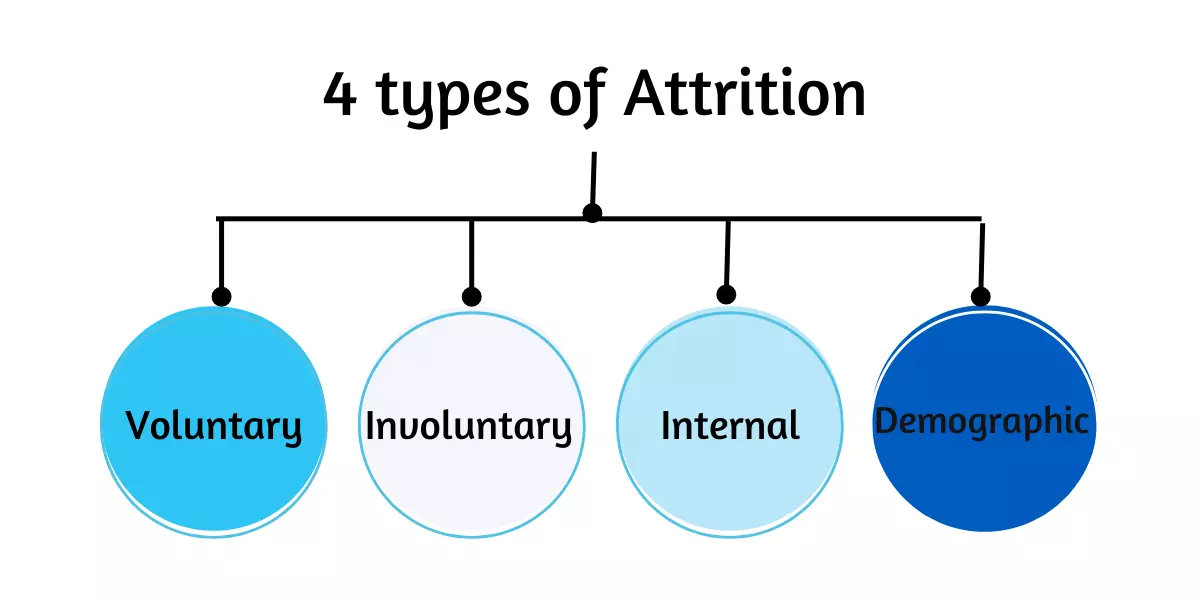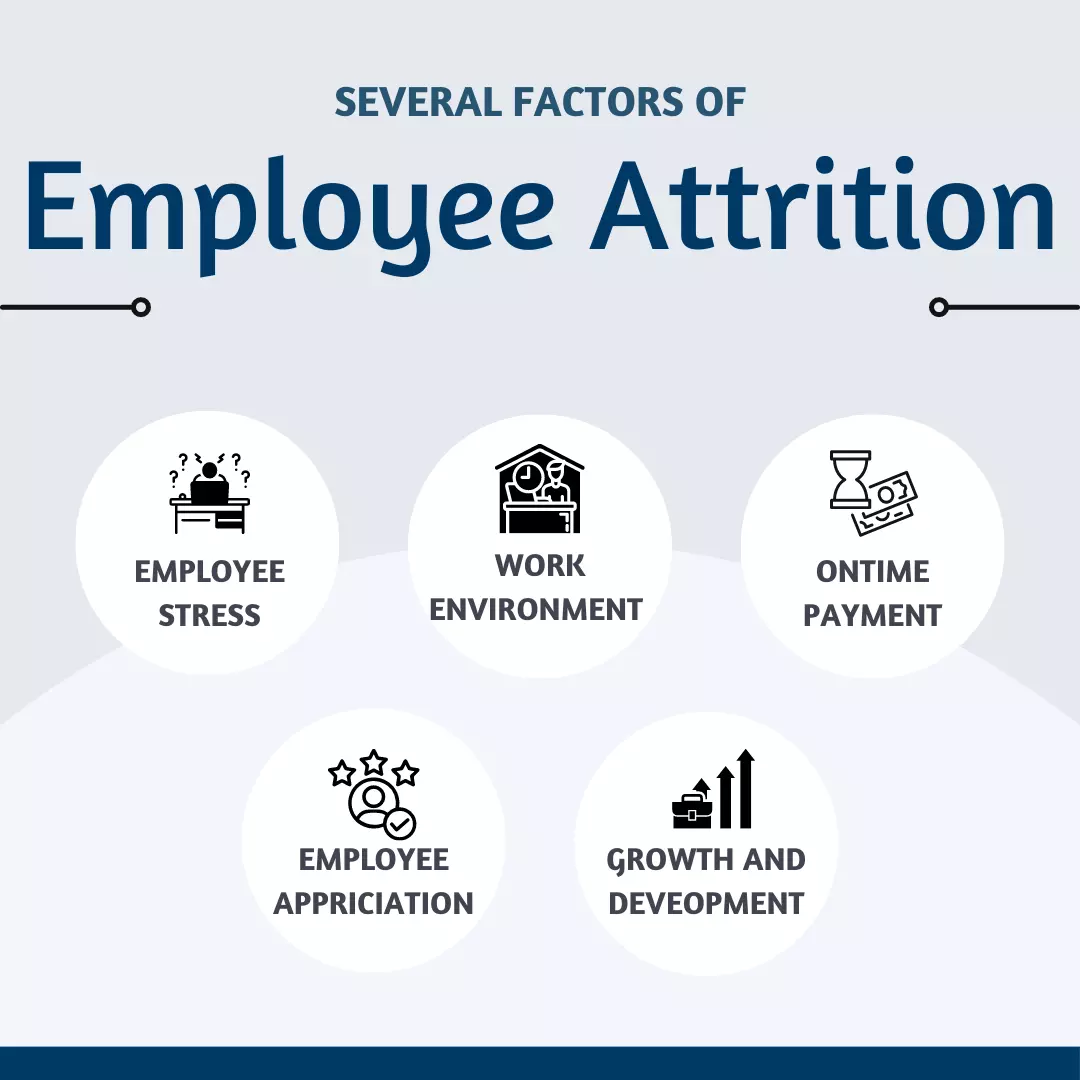Are you facing employee turnover issues recently and thinking about how to solve this problem? First of all, it is a common problem we all face for days, but there are unique ways to resolve them. Have you heard of checking the workplace attrition rate? Is it balanced or do you have to do some work on it?
Checking the employee attrition rate is mandatory. If the rate of staff turnover is detected as high, then you need to bring some changes immediately. Else, productivity and company growth are affected.
In this blog, we are talking about what employee attrition is, how you calculate the employee attrition rate, the benefits of understanding the attrition rate, and more.
What is the Attrition Rate?
Attrition rate is a measuring tool that identifies the ratio of employees who resign from organisations voluntarily or involuntarily. It also represents the percentage of loyal customers of which employee leaves the company.
It is a key indicator that calculates the pace at which people leave a company. It measures how many people or employees leave, voluntarily or involuntarily. Additionally, it helps track average employment duration, and competitive compensation, detects the cost of requirements, training, and exit interview, and maintains customer base and marketing. HRs can measure the attrition rate monthly, quarterly or annually to monitor progress.
With a clarified attrition rate, an organization can figure out how things are going at a company. It provides a clear image of the company’s ultimate growth and productivity.
Also Read:
What is Customer Attrition Rate?
The customer attrition rate, also known as the customer churn rate, is a ratio that is used to measure the percentage of customers who stop doing business with a company during a certain time.
Losing customers haphazardly is a kind of horrifying thing for upbringing a company’s productivity. It is expensive as it cost more to deal with new customers than to retain existing ones. It also creates a business graph with long-lasting employees.
What is the Employee Attrition Rate?
The employee attrition rate, also known as the employee turnover rate, is a metric used to measure the percentage of employees who leave a company during a certain period.
It is an important metric for businesses to monitor because high employee turnover can be costly in terms of recruitment, training, and lost productivity.
How do you Calculate the Attrition Rate Using the Attrition Rate Formula?
To calculate the annual employee attrition rate, You can put the number of attrition divided by the average number of employees and then just multiply the number by 100. Here is the formula,

Attrition rate= No. of attrition/Average no. of employees * 100
But there is confusion that how to measure the number of employees’ attrition or how to calculate the attrition rate specifically. Let’s discuss this in detail.
▸Attrition Number Formula, and Calculations
Let’s take an example of the attrition rate formula and how to calculate the attrition rate. Suppose you have 200 employees at the beginning of 2023, and you like to calculate the attrition rate yearly. Then you have to collect the number of employees who leave. Let’s take the number as 10 and 16 employees are hired.
For calculating the attribution rate for the year 2023, first, you need to subtract the left employee number (10) from the overall number (200) then add the number of hired ones(16).
200 – 10 = 190
180 + 16 = 196
Then, add the number of employees at the start of the period to the total:
200 + 196 = 396
For the average, you have to divide the number (396) by 2
396 / 2 = 198
▸Attrition Rate Calculation
The number of employees who left/ The employee average arrival (10 / 198 = 0.0505) Finally, multiply the decimal by 100 to get the rate of attrition in percentage: 0.0505 x 100 = 5.05%. Alternatively, to overcome this long method of calculation of the percentage/attrition rate, use the percentage calculator by meracalculator that makes it faster, easier, and error-free. Especially for the solution of the decimal numbers, there are the chances of error in calculations.
Difference between Attrition Rate, Retention Rate and Employee Turnover
Often people get confused between attrition and employee retention or attrition and turnover. But in general, all three are different meanings. Let’s discuss it in detail.
▸Attrition vs. Retention
If you confuse the attrition rate and the retention rate. Here are the details. The retention rate measures the percentage of people who stay in a company for a specific long period.
And the attrition rate measures the percentage of employees who leave the company. It is exactly the opposite of attrition metrics.
▸Attrition vs. Turnover
There is a slight difference between the attrition and turnover rate. Even often people confuse two terms.
Attrition is a long-term and calculative concept. It mainly thinks about deeper for the organizational problem and creates a ratio of employees who left and the number of new employees who joined and calculates the company’s productivity. Both voluntary and involuntary employees are included in the attrition rate.
In the case of processing the turnover, only voluntary employees are chosen for the calculations. It is mainly a slight short-term process which focuses on the timely replacement of the resigned employees.
4 Different Types of Attrition

How to segregate the attrition rate? It’s important to identify the types of attrition. Often high attrition rates can bring the effect that leads to less employee morale and satisfaction. The top four categories of employee attrition rates are following;
1. Voluntary Attrition
Voluntary attrition is a type of attrition where the leaves of those employees count, who are taking voluntary leave from the company. Voluntary attrition includes resignation and retirement.
Besides the resignation and retirement often personal problems, poor compensation, higher salary, and benefits, and lack of inclusive practices also lead to contribute the employee’s resignation.
2. Involuntary Attrition
Involuntary attrition is just the opposite of voluntary attrition. When the organization removed the employee from the company for his poor performance, violation of policies or for some typical bad behaviour, etc. So that organization has not faced any negative impact on the company.
3. Internal Attrition
It is a different type of scenario, where the organization change the employee’s current position to another position within the organization.
It can be a promotion or a demotion. But before changing the position, it is important to provide further responsibility details to the employees.
4. Demographic-specific Attrition
Demographic attrition is when the employee left the place for several reasons like workplace harassment, racism at the workplace, etc.
Often one particular employee got affected by the demographic group of people for some random reasons like gender inequality, people of colour, LGBTQ+, etc. Human Resources should take care of these scenarios to ensure that the workplace is not alienating them.
What is a Good Attrition Rate?
Which type of attrition rate is suitable for the company’s growth? or which parameter is detected as a good attrition rate? Here we are discussing basic scenarios of attrition rate.
▸Low Attrition Rate
A low employee attrition rate happens when a company manages to bind their top talent for a specific duration (mainly quarterly, half-yearly, and annual attrition rate) without diverting its resources to train new employees.
A constant low attrition rate leads to employee engagement and provides a conducive environment for business growth. A low attrition rate for years means it is a very productive time for the employer and the entire organization.
▸High Attrition rate
A high attrition rate can have significant negative impacts on an organization. It can lead to increased costs associated with the recruitment, training, and onboarding of new employees. It can also result in decreased productivity due to vacancies in critical positions, increased workload for remaining employees, and decreased morale.
In addition, a high attrition rate can also indicate underlying issues within the organization, such as poor management practices, lack of career development opportunities, low employee engagement, or other factors that are contributing to employee dissatisfaction and turnover.
▸Average Attrition Rate
Almost every company deals with the average attrition rate. It mainly varies widely depending on the specific organization and circumstances. For example, some industries with high turnover rates, such as retail or hospitality, may have attrition rates significantly higher than the average. Conversely, some industries with low turnover rates, such as healthcare or government, may have attrition rates significantly lower than the average.
The average attrition rate fluctuates based on factors, including the economy, industry trends, company culture, employee engagement, compensation and benefits, and many others. Therefore, it is important for organizations to regularly monitor their attrition rates and benchmark them against industry averages to identify potential issues and take proactive steps to address them.
Is a High Attrition Rate Always a Bad Thing?
No, not at all. The high attrition rate is a good thing often as well. Let’s take a detailed scenario. If a company plan to change or restructured its company then it is normal that the attrition rate can be high.
But if in case the best employees take voluntary attrition and the leaving frequently for better availability then you should reduce attrition immediately. keep in mind that the attrition rate varies widely.
Several Factors of High Attrition Rate

▸Stress
Employee stress due to some personal reason or some professional reason increase the company’s attrition rate.
Maintaining employee health and wealth in the workplace is one of the key responsibilities of HR professionals maintaining employee satisfaction that ensures the business performance as well.
▸Company and Work Environment
A toxic work environment can be one of the main reasons for a higher attrition rate.
▸Pay
Paying fair wages with good benefits can be a great option for preventing the employee’s higher attrition rate and increasing employee retention.
▸Appreciation
Employees always love to be appreciated. Timely recognition, motivation and appreciation can increase retention, improvise the employee experience, increase stress, and build the company’s productivity in the workplace as well.
▸Growth and Development
Employees also like to have work-life balance and growth in their career paths. They always like know to learn something new from their organization.
Sa arranging some training or employee self-development can be a good way to nurture employees, reduce the high turnover rate and experience company success.
How to Reduce the High Attrition Rate?
1. Plan for Incentives
Providing certain incentives to the employees who deserve them is one of the best ways to retain employees and reduce the high attrition rate.
2. Create a Satisfaction Survey
Surveying employees is one of the effective ways, to reduce the employee attrition rate. Through the Yearly Monthly, and Quarterly basis surveys organization leaders can specifically design a custom questionnaire for the employee.
A healthy survey not only is the finest way to list down the employees’ reasons for resigning but also improves communication and intimidates the company culture.
3. Leave a Door Open to Return
It is essential to send off the employees with gratitude and warm wishes for further professional life. Exit interviews of the employees leaving must be done positively. Through this process, you can leave a door open to return.
4. Reward or Appreciate Employees
Praising employees’ hard work, and encouraging them for contributing more. Rewarding them for their contribution or appreciating their excellence is the best way for the company’s success.
5. Promote Employee Health and Wellness
Employee wellness programs can be an effective way to improve employee retention rates by promoting a healthier, more engaged workforce.
Organizations must focus on physical, mental, and emotional health can help employees feel more supported, valued, and satisfied. When employees feel that their employer cares about their well-being, they are more likely to stay with the organization.
Also Read:
Why Does an Employee Attrition Rate Matter?
Employee attrition rate refers to the rate at which employees leave an organization, either voluntarily or involuntarily, over a certain period. It is an important metric that measures the rate of turnover within an organization.
There are several reasons why an employee attrition rate matters. Here are a few of the most significant:
▸Cost
Employee turnover is costly. Replacing an employee involves a significant amount of time and resources, including recruitment, training, and onboarding costs.
By measuring the attrition rate, companies can estimate the financial impact of employee turnover and take steps to reduce it.
▸Productivity
High employee turnover can negatively impact productivity. When employees leave, there is often a period when the position is left unfilled, which can lead to decreased productivity, increased workload for remaining employees, and decreased morale.
▸Employee Engagement
A high employee attrition rate can be a symptom of low employee engagement. When employees are not engaged, they are more likely to leave the organization.
By measuring attrition rates, companies can identify areas where employee engagement is low and take steps to improve it.
▸Reputation
High employee turnover can also damage a company’s reputation. Potential employees may be hesitant to apply to a company with a high attrition rate, and customers may perceive high turnover as a sign of instability or a lack of commitment to employees.
In Summary
employee attrition rate matters because it can have significant financial, productivity, engagement, and reputational impacts on an organization. By measuring and addressing attrition rates, companies can improve employee retention, engagement, and overall organizational performance.








